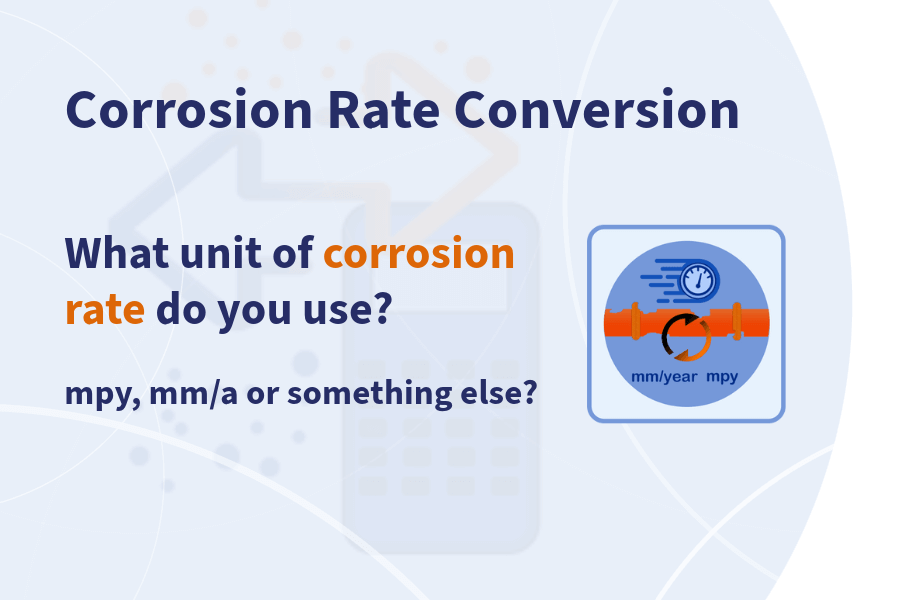
The conversion of different units of corrosion rate or corrosion penetration rate has a simple rule. However, it is not always fast and easy. Corrosion rate makes use of different unit types, and we may need density, valance, or molecular weight for conversion.
Corrosion Rate Conversion for Steel
First, for the sake of simplicity, we extract the conversion coefficient for steel, which we assume as pure Fe. In this case:
1 mA/cm² = 11.6 mm/year = 456 mpy = 249 g/m2.day
You can find some examples in the below table:
| Unit | 0.01 mA/cm² | 0.0862 mA/cm² | 0.22 mA/cm² | 0.4 mA/cm² | 1 mA/cm² | 8.62 mA/cm² | 50 mA/cm² | 100 mA/cm² |
| mA/cm² | 0.010 | 0.0862 | 0.22 | 0.400 | 1.000 | 8.62 | 50 | 100 |
| mm/year | 0.116 | 1.000 | 2.552 | 4.640 | 11.60 | 100.0 | 580 | 1160 |
| mpy | 4.560 | 39.31 | 100.3 | 182.4 | 456 | 3931 | 22800 | 45600 |
| g/m2.day | 2.490 | 21.46 | 54.78 | 99.60 | 249 | 2146 | 12450 | 24900 |
General Corrosion Rate Conversion
As a general rule, we should extract the coefficient for different units, resulting in the following:
1 mA/cm² = (3.28 M/m x d) mm/year = (129 M / m x d) mpy = (8.95 M/m) g/m2.day
where M is molecular weight gr/mol, m is the valance of corrosion state, and d is the density of material gr/cm3. You can find the solved sample in the below table:
| Unit | M (gr/mol) | m (Valance) | Density (gr/cm²) | Conversion Coefficient | 0.01 mA/cm² | 0.0862 mA/cm² | 0.22 mA/cm² | 0.4 mA/cm² | 1 mA/cm² | 8.62 mA/cm² | 50 mA/cm² | 100 mA/cm² |
| mA/cm² | 55.845 | 2 | 7.87 | 1 | 0.010 | 0.0862 | 0.220 | 0.400 | 1.000 | 8.620 | 50.00 | 100.00 |
| mm/year | 55.845 | 2 | 7.87 | 11.637 | 0.116 | 1.003 | 2.560 | 4.655 | 11.64 | 100.3 | 581.9 | 1164 |
| mm/year | 26.98 | 3 | 2.7 | 10.925 | 0.109 | 0.9418 | 2.404 | 4.370 | 10.93 | 94.18 | 546.3 | 1093 |
| mm/year | 65.38 | 2 | 7.133 | 15.032 | 0.150 | 1.296 | 3.307 | 6.013 | 15.03 | 129.6 | 751.6 | 1503 |
| mm/year | 24.3 | 2 | 1.738 | 22.930 | 0.229 | 1.977 | 5.045 | 9.172 | 22.93 | 197.7 | 1146 | 2293 |
| mpy | 55.845 | 2 | 7.87 | 457.688 | 4.577 | 39.45 | 100.7 | 183.1 | 457.7 | 3945 | 22884 | 45769 |
| mpy | 26.98 | 3 | 2.7 | 429.681 | 4.297 | 37.04 | 94.53 | 171.9 | 429.7 | 3704 | 21484 | 42968 |
| mpy | 65.38 | 2 | 7.133 | 591.197 | 5.912 | 50.96 | 130.1 | 236.5 | 591.2 | 5096 | 29560 | 59120 |
| mpy | 24.3 | 2 | 1.738 | 901.812 | 9.018 | 77.74 | 198.4 | 360.7 | 901.8 | 7774 | 45091 | 90181 |
| g/m2.day | 55.845 | 2 | 7.87 | 249.906 | 2.499 | 21.54 | 54.98 | 100.0 | 249.9 | 2154 | 12495 | 24991 |
It is best to read both tables vertically. You can find the equivalent corrosion rate to the anodic mentioned current density in each column.